Author’s Note and Update
Today, the dangers of military escalation are beyond description.
What is now happening in Ukraine has serious geopolitical implications. It could lead us into a World War III Scenario.
Vladimir Putin’s statement on February 21st, 2022 was in response to US threats to use nuclear weapons on a preemptive basis against Russia, despite Joe Biden’s “reassurance” that the US would not be resorting to “A First Strike” nuclear attack against an enemy of America.
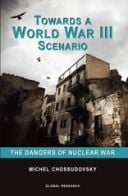 The article below first published in February 2006 addresses US Military Doctrine focussing on the integration of nuclear and conventional warfare.
The article below first published in February 2006 addresses US Military Doctrine focussing on the integration of nuclear and conventional warfare.
The results of this research were subsequently integrated into my book entitled Towards A World War Three Scenario, The Dangers of Nuclear War, Global Research Publishers, 2011.
Having carefully reviewed US military doctrine for more than 20 years, I can confirm that under the Biden Administration, preemptive nuclear war against Russia, China, Iran and North Korea is “on the table”.
It should be noted that Joe Biden’s 1.2 trillion dollars nuclear weapons program is slated to increase to 2 trillion by 2030 allegedly as a means to safeguarding peace and national security at taxpayers expense.
How many schools and hospitals could you finance with 2 trillion dollars?
Truth is a Powerful and Peaceful Weapon, which is the object of Google and Facebook censorship.
Nuclear War Threatens the Future of Humanity. No mainstream media analysis. That statement is the object of censorship.
Say No to Joe Biden’s $1.2 Trillion Nuclear Weapons Program.
SAY YES TO WORLD PEACE
Please forward this article, post it on your blog. Spread the word. Initiate a campaign against nuclear war.
Michel Chossudovsky, Global Research, March 11, 2022
***
It Started with Harry Truman
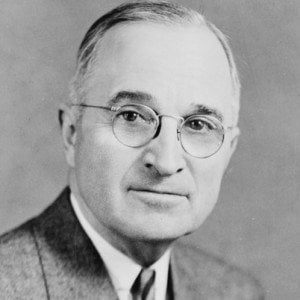 “We have discovered the most terrible bomb in the history of the world. It may be the fire destruction prophesied in the Euphrates Valley Era, after Noah and his fabulous Ark…. This weapon is to be used against Japan … [We] will use it so that military objectives and soldiers and sailors are the target and not women and children. Even if the Japs are savages, ruthless, merciless and fanatic, we as the leader of the world for the common welfare cannot drop that terrible bomb on the old capital or the new. … The target will be a purely military one… It seems to be the most terrible thing ever discovered, but it can be made the most useful.”
“We have discovered the most terrible bomb in the history of the world. It may be the fire destruction prophesied in the Euphrates Valley Era, after Noah and his fabulous Ark…. This weapon is to be used against Japan … [We] will use it so that military objectives and soldiers and sailors are the target and not women and children. Even if the Japs are savages, ruthless, merciless and fanatic, we as the leader of the world for the common welfare cannot drop that terrible bomb on the old capital or the new. … The target will be a purely military one… It seems to be the most terrible thing ever discovered, but it can be made the most useful.”
(President Harry S. Truman, Diary, July 25, 1945)
Remember Hiroshima: “A Military Base” according to Harry Truman
“The World will note that the first atomic bomb was dropped on Hiroshima a military base. That was because we wished in this first attack to avoid, insofar as possible, the killing of civilians..” (President Harry S. Truman in a radio speech to the Nation, August 9, 1945).
[Note: the first atomic bomb was dropped on Hiroshima on August 6, 1945; the Second on Nagasaki, on August 9, on the same day as Truman’s radio speech to the Nation]
(Listen to Excerpt of Truman’s speech, Hiroshima audio video, link n longer active)
The Unthinkable
At no point since the first atomic bomb was dropped on Hiroshima on August 6th, 1945, has humanity been closer to the unthinkable. All the safeguards of the Cold War era, which categorized the nuclear bomb as “a weapon of last resort” have been scrapped. “Offensive” military actions using nuclear warheads are now described as acts of “self-defense”.
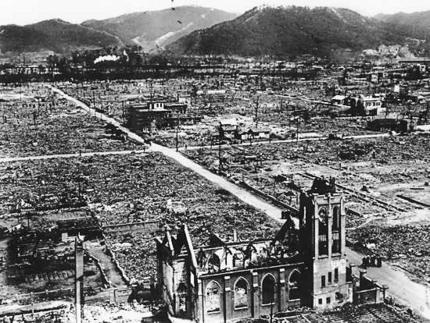
The distinction between tactical nuclear weapons and the conventional battlefield arsenal has been blurred. America’s new nuclear doctrine is based on “a mix of strike capabilities”. The latter, which specifically applies to the Pentagon’s planned aerial bombing of Iran, envisages the use of nukes in combination with conventional weapons.
As in the case of the first atomic bomb, which in the words of President Harry Truman “was dropped on Hiroshima, a military base”, today’s “mini-nukes” are heralded as “safe for the surrounding civilian population”.
The Dangerous Doctrine for Joint Nuclear Operations
Known in official Washington, as “Joint Publication 3-12”, the new nuclear doctrine (Doctrine for Joint Nuclear Operations (DJNO) (March 2005)) calls for “integrating conventional and nuclear attacks” under a unified and “integrated” Command and Control (C2).
It largely describes war planning as a management decision-making process, where military and strategic objectives are to be achieved, through a mix of instruments, with little concern for the resulting loss of human life.
The Pentagon’s Toolbox
Military planning focuses on “the most efficient use of force” , -i.e. an optimal arrangement of different weapons systems to achieve stated military goals.
In this context, nuclear and conventional weapons are considered to be “part of the tool box”, from which military commanders can pick and choose the instruments that they require in accordance with “evolving circumstances” in the war theater.
None of these weapons in the Pentagon’s “tool box”, including conventional bunker buster bombs, cluster bombs, mini-nukes, chemical and biological weapons are described as “weapons of mass destruction” when used by the United States of America and its coalition partners.
The stated objective is to:
“ensure the most efficient use of force and provide US leaders with a broader range of [nuclear and conventional] strike options to address immediate contingencies. Integration of conventional and nuclear forces is therefore crucial to the success of any comprehensive strategy. This integration will ensure optimal targeting, minimal collateral damage, and reduce the probability of escalation.” (Doctrine for Joint Nuclear Operations p. JP 3-12-13) emphasis added
The New Nuclear Doctrine turns Concepts and Realities Upside Down
It not only denies the devastating impacts of nuclear weapons, it states, in no uncertain terms, that nuclear weapons are “safe” and their use in the battlefield will ensure “minimal collateral damage and reduce the probability of escalation”.
The issue of radioactive fallout is barely acknowledged with regard to tactical nuclear weapons. These various guiding principles which describe nukes as “safe for civilians” constitute a consensus within the military, which is then fed into the military manuals, providing relevant “green light” criteria to geographical commanders in the war theater.
“Defensive” and “Offensive” Actions
While the 2001 Nuclear Posture Review sets the stage for the preemptive use of nuclear weapons in the Middle East, specifically against Iran (see also the main PNAC document Rebuilding America`s Defenses, Strategy, Forces and Resources for a New Century ), The Doctrine for Joint Nuclear Operations goes one step further in blurring the distinction between “defensive” and “offensive” military actions:
“The new triad offers a mix of strategic offensive and defensive capabilities that includes nuclear and non-nuclear strike capabilities, active and passive defenses, and a robust research, development, and industrial infrastructure to develop, build, and maintain offensive forces and defensive systems …” (Ibid) (key concepts indicated in added italics)
The new nuclear doctrine, however, goes beyond preemptive acts of “self-defense”, it calls for “anticipatory action” using nuclear weapons against a “rogue enemy” which allegedly plans to develop WMD at some undefined future date:
Responsible security planning requires preparation for threats that are possible, though perhaps unlikely today. The lessons of military history remain clear: unpredictable, irrational conflicts occur. Military forces must prepare to counter weapons and capabilities that exist or will exist in the near term even if no immediate likely scenarios for war are at hand. To maximize deterrence of WMD use, it is essential US forces prepare to use nuclear weapons effectively and that US forces are determined to employ nuclear weapons if necessary to prevent or retaliate against WMD use. (Ibid, p. III-1, italics added)
Nukes would serve to prevent a non-existent WMD program (e.g. Iran) prior to its development. This twisted formulation goes far beyond the premises of the 2001 Nuclear Posture Review and NPSD 17. which state that the US can retaliate with nuclear weapons if attacked with WMD:
“The United States will make clear that it reserves the right to respond with overwhelming force – including potentially nuclear weapons – to the use of [weapons of mass destruction] against the United States, our forces abroad, and friends and allies.” … (NSPD 17)
“Integration” of Nuclear and Conventional Weapons Plans
The Doctrine for Joint Nuclear Operations outlines the procedures governing the use of nuclear weapons and the nature of the relationship between nuclear and conventional war operations.
The DJNO states that the:
“use of nuclear weapons within a [war] theater requires that nuclear and conventional plans be integrated to the greatest extent possible”
(DJNO, p 47 italics added, italics added, For further details see Michel Chossudovsky, Nuclear War against Iran, Jan 2006 )
The implications of this “integration” are far-reaching because once the decision is taken by the Commander in Chief, namely the President of the United States, to launch a joint conventional-nuclear military operation, there is a risk that tactical nuclear weapons could be used without requesting subsequent presidential approval.
In this regard, execution procedures under the jurisdiction of the theater commanders pertaining to nuclear weapons are described as “flexible and allow for changes in the situation”:
“Geographic combatant commanders are responsible for defining theater objectives and developing nuclear plans required to support those objectives, including selecting targets. When tasked, CDRUSSTRATCOM, as a supporting combatant commander, provides detailed planning support to meet theater planning requirements. All theater nuclear option planning follows prescribed Joint Operation Planning and Execution System procedures to formulate and implement an effective response within the timeframe permitted by the crisis..
Since options do not exist for every scenario, combatant commanders must have a capability to perform crisis action planning and execute those plans. Crisis action planning provides the capability to develop new options, or modify existing options, when current limited or major response options are inappropriate.
…Command, control, and coordination must be flexible enough to allow the geographic combatant commander to strike time-sensitive targets such as mobile missile launch platforms.” Doctrine for Joint Nuclear Operations Doctrine (italics added)
Theater Nuclear Operations (TNO)
While presidential approval is formally required to launch a nuclear war, geographic combat commanders would be in charge of Theater Nuclear Operations (TNO), with a mandate not only to implement but also to formulate command decisions pertaining to nuclear weapons. ( Doctrine for Joint Nuclear Operations Doctrine )
We are no longer dealing with “the risk” associated with “an accidental or inadvertent nuclear launch” as outlined by former Secretary of Defense Robert S. McNamara , but with a military decision-making process which provides military commanders, from the Commander in Chief down to the geographical commanders with discretionary powers to use tactical nuclear weapons.
Moreover, because these “smaller” tactical nuclear weapons have been “reclassified” by the Pentagon as “safe for the surrounding civilian population”, thereby “minimizing the risk of collateral damage”, there are no overriding built-in restrictions which prevent their use. (See Michel Chossudovsky, The Dangers of a Middle East Nuclear War , Global Research, February 2006) .
Once a decision to launch a military operation is taken (e.g. aerial strikes on Iran), theater commanders have a degree of latitude. What this signifies in practice is once the presidential decision is taken, USSTRATCOM in liaison with theater commanders can decide on the targeting and type of weaponry to be used. Stockpiled tactical nuclear weapons are now considered to be an integral part of the battlefield arsenal. In other words, nukes have become “part of the tool box”, used in conventional war theaters.
Planned Aerial Attacks on Iran
An operational plan to wage aerial attacks on Iran has been in “a state of readiness” since June 2005. Essential military hardware to wage this operation has been deployed. (For further details see Michel Chossudovsky, Nuclear War against Iran, Jan 2006 ).
Vice President Dick Cheney has ordered USSTRATCOM to draft a “contingency plan”, which “includes a large-scale air assault on Iran employing both conventional and tactical nuclear weapons.” (Philip Giraldi, Attack on Iran: Pre-emptive Nuclear War , The American Conservative, 2 August 2005).
USSTRATCOM would have the responsibility for overseeing and coordinating this military deployment as well as launching the military operation. (For details, Michel Chossudovsky, Nuclear War against Iran, Jan 2006 ).
In January 2005 a significant shift in USSTRATCOM’s mandate was implemented. USSTRATCOM was identified as “the lead Combatant Command for integration and synchronization of DoD-wide efforts in combating weapons of mass destruction.” To implement this mandate, a brand new command unit entitled Joint Functional Component Command Space and Global Strike , or JFCCSGS was created.
Overseen by USSTRATCOM, JFCCSGS would be responsible for the launching of military operations “using nuclear or conventional weapons” in compliance with the Bush administration’s new nuclear doctrine. Both categories of weapons would be integrated into a “joint strike operation” under unified Command and Control.
According to Robert S. Norris and Hans M. Kristensen, writing in the Bulletin of Atomic Scientists,
“The Defense Department is upgrading its nuclear strike plans to reflect new presidential guidance and a transition in war planning from the top-heavy Single Integrated Operational Plan of the Cold War to a family of smaller and more flexible strike plans designed to defeat today’s adversaries. The new central strategic war plan is known as OPLAN (Operations Plan) 8044…. This revised, detailed plan provides more flexible options to assure allies, and dissuade, deter, and if necessary, defeat adversaries in a wider range of contingencies….
One member of the new family is CONPLAN 8022, a concept plan for the quick use of nuclear, conventional, or information warfare capabilities to destroy–preemptively, if necessary–“time-urgent targets” anywhere in the world. Defense Secretary Donald Rumsfeld issued an Alert Order in early 2004 that directed the military to put CONPLAN 8022 into effect. As a result, the Bush administration’s preemption policy is now operational on long-range bombers, strategic submarines on deterrent patrol, and presumably intercontinental ballistic missiles (ICBMs).”
The operational implementation of the Global Strike would be under CONCEPT PLAN (CONPLAN) 8022, which now consists of “an actual plan that the Navy and the Air Force translate into strike package for their submarines and bombers,’ (Japanese Economic Newswire, 30 December 2005, For further details see Michel Chossudovsky, Nuclear War against Iran, op. cit.).
CONPLAN 8022 is ‘the overall umbrella plan for sort of the pre-planned strategic scenarios involving nuclear weapons.’
‘It’s specifically focused on these new types of threats — Iran, North Korea — proliferators and potentially terrorists too,’ he said. ‘There’s nothing that says that they can’t use CONPLAN 8022 in limited scenarios against Russian and Chinese targets.’ (According to Hans Kristensen, of the Nuclear Information Project, quoted in Japanese Economic News Wire, op. cit.)
Nuclear Weapons Deployment Authorization
The planning of the aerial bombings of Iran started in mid-2004, pursuant to the formulation of CONPLAN 8022 in early 2004. In May 2004, National Security Presidential Directive NSPD 35 entitled Nuclear Weapons Deployment Authorization was issued.
The contents of this highly sensitive document remains a carefully guarded State secret. There has been no mention of NSPD 35 by the media nor even in Congressional debates. While its contents remains classified, the presumption is that NSPD 35 pertains to the deployment of tactical nuclear weapons in the Middle East war theater in compliance with CONPLAN 8022.
In this regard, a recent press report published in Yeni Safak (Turkey) suggests that the United States is currently:
“deploying B61-type tactical nuclear weapons in southern Iraq as part of a plan to hit Iran from this area if and when Iran responds to an Israeli attack on its nuclear facilities”. (Ibrahim Karagul, “The US is Deploying Nuclear Weapons in Iraq Against Iran”, (Yeni Safak,. 20 December 2005, quoted in BBC Monitoring Europe).
This deployment in Iraq appears to be pursuant to NSPD 35 ,
What the Yenbi Safak report suggests is that conventional weapons would be used in the first instance, and if Iran were to retaliate in response to US-Israeli aerial attacks, tactical thermonuclear B61 weapons could then be launched This retaliation using tactical nuclear weapons would be consistent with the guidelines contained in the 2001 Nuclear Posture Review and NSPD 17 (see above).
Israel’s Stockpiling of Conventional and Nuclear Weapons
Israel is part of the military alliance and is slated to play a major role in the planned attacks on Iran. (For details see Michel Chossudovsky, Nuclear War against Iran, Jan 2006 ).
Confirmed by several press reports, Israel has taken delivery, starting in September 2004 of some 500 US produced BLU 109 bunker buster bombs (WP, January 6, 2006). The first procurement order for BLU 109 [Bomb Live Unit] dates to September 2004. In April 2005, Washington confirmed that Israel was to take delivery of 100 of the more sophisticated bunker buster bomb GBU-28 produced by Lockheed Martin ( Reuters, April 26, 2005). The GBU-28 is described as “a 5,000-pound laser-guided conventional munitions that uses a 4,400-pound penetrating warhead.” It was used in the Iraqi war theater:
The Pentagon [stated] that … the sale to Israel of 500 BLU-109 warheads, [was] meant to “contribute significantly to U.S. strategic and tactical objectives.” .
Mounted on satellite-guided bombs, BLU-109s can be fired from F-15 or F-16 jets, U.S.-made aircraft in Israel’s arsenal. This year Israel received the first of a fleet of 102 long-range F-16Is from Washington, its main ally. “Israel very likely manufactures its own bunker busters, but they are not as robust as the 2,000-pound (910 kg) BLUs,” Robert Hewson, editor of Jane’s Air-Launched Weapons, told Reuters. (Reuters, 21 September 2004)
The report does not confirm whether Israel has stockpiled and deployed the thermonuclear version of the bunker buster bomb. Nor does it indicate whether the Israeli made bunker buster bombs are equipped with nuclear warheads. It is worth noting that this stock piling of bunker buster bombs occurred within a few months after the Release of the NPSD 35¸ Nuclear Weapons Deployment Authorization (May 2004).
Israel possesses 100-200 strategic nuclear warheads . In 2003, Washington and Tel Aviv confirmed that they were collaborating in “the deployment of US-supplied Harpoon cruise missiles armed with nuclear warheads in Israel’s fleet of Dolphin-class submarines.” (The Observer, 12 October 2003) . In more recent developments, which coincide with the preparations of strikes against Iran, Israel has taken delivery of two new German produced submarines “that could launch nuclear-armed cruise missiles for a “second-strike” deterrent.” (Newsweek, 13 February 2006. See also CDI Data Base)
Israel’s tactical nuclear weapons capabilities are not known
Israel’s participation in the aerial attacks will also act as a political bombshell throughout the Middle East. It would contribute to escalation, with a war zone which could extend initially into Lebanon and Syria. The entire region from the Eastern Mediterranean to Central Asia and Afghanistan’s Western frontier would be affected..
The Role of Western Europe
Several Western European countries, officially considered as “non-nuclear states”, possess tactical nuclear weapons, supplied to them by Washington.
The US has supplied some 480 B61 thermonuclear bombs to five non-nuclear NATO countries including Belgium, Germany, Italy, the Netherlands and Turkey, and one nuclear country, the United Kingdom. Casually disregarded by the Vienna based UN Nuclear Watch, the US has actively contributed to the proliferation of nuclear weapons in Western Europe.
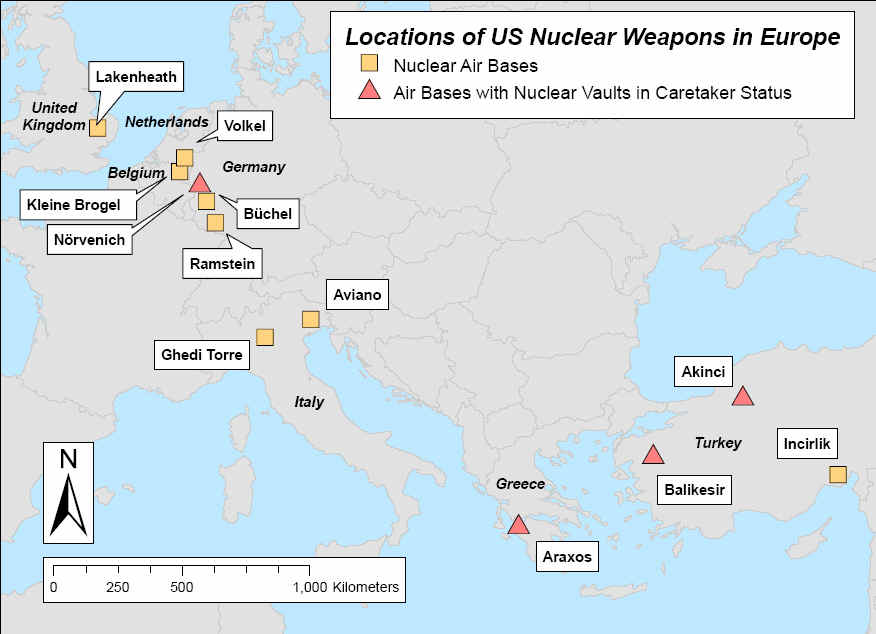
As part of this European stockpiling, Turkey, which is a partner of the US-led coalition against Iran along with Israel, possesses some 90 thermonuclear B61 bunker buster bombs at the Incirlik nuclear air base. (National Resources Defense Council, Nuclear Weapons in Europe , February 2005)
Consistent with US nuclear policy, the stockpiling and deployment of B61 in Western Europe are intended for targets in the Middle East. Moreover, in accordance with “NATO strike plans”, these thermonuclear B61 bunker buster bombs (stockpiled by the “non-nuclear States”) could be launched “against targets in Russia or countries in the Middle East such as Syria and Iran” ( quoted in National Resources Defense Council, Nuclear Weapons in Europe , February 2005)
Moreover, confirmed by (partially) declassified documents (released under the U.S. Freedom of Information Act):
“arrangements were made in the mid-1990s to allow the use of U.S. nuclear forces in Europe outside the area of responsibility of U.S. European Command (EUCOM). As a result of these arrangements, EUCOM now supports CENTCOM nuclear missions in the Middle East, including, potentially, against Iran and Syria”
(quoted in http://www.nukestrat.com/us/afn/nato.htm italics added)
With the exception of the US, no other nuclear power “has nuclear weapons earmarked for delivery by non-nuclear countries.” (National Resources Defense Council, op cit)
While these “non-nuclear states” casually accuse Tehran of developing nuclear weapons, without documentary evidence, they themselves have capabilities of delivering nuclear warheads, which are targeted at Iran. To say that this is a clear case of “double standards” by the IAEA and the “international community” is a understatement.
Germany: De Facto Nuclear Power
Among the five “non-nuclear states” “Germany remains the most heavily nuclearized country with three nuclear bases (two of which are fully operational) and may store as many as 150 [B61 bunker buster ] bombs” (Ibid). In accordance with “NATO strike plans” (mentioned above) these tactical nuclear weapons are also targeted at the Middle East.
While Germany is not officially a nuclear power, it produces nuclear warheads for the French Navy. It stockpiles nuclear warheads and it has the capabilities of delivering nuclear weapons. The European Aeronautic Defense and Space Company – EADS , a Franco-German-Spanish joint venture, controlled by Deutsche Aerospace and the powerful Daimler Group is Europe’s second largest military producer, supplying .France’s M51 nuclear missile.
France Endorses the Preemptive Nuclear Doctrine
In January 2006, French President Jacques Chirac announced a major shift in France’s nuclear policy.
Without mentioning Iran, Chirac intimated that France’s nukes should be used in the form of “more focused attacks” against countries, which were “considering” the deployment of Weapons of Mass Destruction (WMD).
He also hinted to the possibility that tactical nuclear weapons could be used in conventional war theaters, very much in line with both US and NATO nuclear doctrine (See Chirac shifts French doctrine for use of nuclear weapons , Nucleonics Week January 26, 2006).
The French president seems to have embraced the US sponsored “War on Terrorism”. He presented nuclear weapons as a means to build a safer World and combat terrorism:
Nuclear weapons are not meant to be used against “fanatical terrorists,” nevertheless “the leaders of states which used terrorist means against us, as well as those who considered using, in one way or another, weapons of mass destruction, must understand that they are exposing themselves to a firm, appropriate response on our side…”.(Ibid)
Although Chirac made no reference to the preemptive use of nuclear weapons, his statement broadly replicates the premises of the Bush administration’s 2001 Nuclear Posture Review , which calls for the use of tactical nuclear weapons against ”rogue states” and “terrorist non-state organizations”.
The stockpiled weapons are B61 thermonuclear bombs. All the weapons are gravity bombs of the B61-3, -4, and -10 types.2 .
Those estimates were based on private and public statements by a number of government sources and assumptions about the weapon storage capacity at each base
.(National Resources Defense Council, Nuclear Weapons in Europe , February 2005)
Building a Pretext for a Preemptive Nuclear Attack
The pretext for waging war on Iran essentially rests on two fundamental premises, which are part of the Bush administration’s National Security doctrine.
1. Iran’s alleged possession of “Weapons of Mass Destruction” (WMD), more specifically its nuclear enrichment program.
2. Iran’s alleged support to “Islamic terrorists”.
These are two interrelated statements which are an integral part of the propaganda and media disinformation campaign.
The “Weapons of Mass Destruction (WMD)” statement is used to justify the “pre-emptive war” against the “State sponsors of terror”, –i.e. countries such as Iran and North Korea which allegedly possess WMD. Iran is identified as a State sponsor of so-called “non-State terrorist organizations”. The latter also possess WMDs and potentially constitute a nuclear threat. Terrorist non-state organizations are presented as a “nuclear power”.
“The enemies in this [long] war are not traditional conventional military forces but rather dispersed, global terrorist networks that exploit Islam to advance radical political aims. These enemies have the avowed aim of acquiring and using nuclear and biological weapons to murder hundreds of thousands of Americans and others around the world.” (2006 Quadrennial Defense Review ),
In contrast, Germany and Israel which produce and possess nuclear warheads are not considered “nuclear powers”.
In recent months, the pretext for war, building on this WMD-Islamic terrorist nexus, has been highlighted ad nauseam, on a daily basis by the Western media.
In a testimony to the US Senate Budget Committee, Secretary of State Condoleezza Rice accused Iran and Syria of destabilizing the Middle East and providing support to militant Islamic groups. She described Iran as the “a central banker for terrorism”, not withstanding the fact amply documented that Al Qaeda has been supported and financed from its inception in the early 1980s by none other than the CIA. (See Michel Chossudovsky, Who is Osama bin Laden, Global Research 2001).
“It’s not just Iran’s nuclear program but also their support for terrorism around the world. They are, in effect, the central banker for terrorism,” (Statement to the Senate Budget Committee, 16 February 2006)
“Second 9/11”: Cheney’s “Contingency Plan”
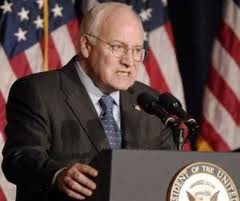 While the “threat” of Iran’s alleged WMD is slated for debate at the UN Security Council, Vice President Dick Cheney is reported to have instructed USSTRATCOM to draw up a contingency plan “to be employed in response to another 9/11-type terrorist attack on the United States”. This “contingency plan” to attack Iran uses the pretext of a “Second 9/11” which has not yet happened, to prepare for a major military operation against Iran.
While the “threat” of Iran’s alleged WMD is slated for debate at the UN Security Council, Vice President Dick Cheney is reported to have instructed USSTRATCOM to draw up a contingency plan “to be employed in response to another 9/11-type terrorist attack on the United States”. This “contingency plan” to attack Iran uses the pretext of a “Second 9/11” which has not yet happened, to prepare for a major military operation against Iran.
The contingency plan, which is characterized by a military build up in anticipation of possible aerial strikes against Iran, is in a “state of readiness”.
What is diabolical is that the justification to wage war on Iran rests on Iran’s involvement in a terrorist attack on America, which has not yet occurred:
The plan includes a large-scale air assault on Iran employing both conventional and tactical nuclear weapons. Within Iran there are more than 450 major strategic targets, including numerous suspected nuclear-weapons-program development sites. Many of the targets are hardened or are deep underground and could not be taken out by conventional weapons, hence the nuclear option. As in the case of Iraq, the response is not conditional on Iran actually being involved in the act of terrorism directed against the United States. Several senior Air Force officers involved in the planning are reportedly appalled at the implications of what they are doing—that Iran is being set up for an unprovoked nuclear attack—but no one is prepared to damage his career by posing any objections. (Philip Giraldi, Attack on Iran: Pre-emptive Nuclear War , The American Conservative, 2 August 2005)
Are we to understand that US military planners are waiting in limbo for a Second 9/11, to launch a military operation directed against Iran, which is currently in a “state of readiness”?
Cheney’s proposed “contingency plan” does not focus on preventing a Second 9/11. The Cheney plan is predicated on the presumption that Iran would be behind a Second 9/11 and that punitive bombings would immediately be activated, prior to the conduct of an investigation, much in the same way as the attacks on Afghanistan in October 2001, allegedly in retribution for the role of the Taliban government in support of the 9/11 terrorists. It is worth noting that the bombing and invasion of Afghanistan had been planned well in advance of 9/11. As Michael Keefer points out in an incisive review article:
“At a deeper level, it implies that “9/11-type terrorist attacks” are recognized in Cheney’s office and the Pentagon as appropriate means of legitimizing wars of aggression against any country selected for that treatment by the regime and its corporate propaganda-amplification system…. (Keefer, February 2006 )
Keefer concludes that “an attack on Iran, which would presumably involve the use of significant numbers of extremely ‘dirty’ earth-penetrating nuclear bombs, might well be made to follow a dirty-bomb attack on the United States, which would be represented in the media as having been carried out by Iranian agents” (Keefer, February 2006 )
The Battle for Oil
The Anglo-American oil companies are indelibly behind Cheney’s “contingency plan” to wage war on Iran. The latter is geared towards territorial and corporate control over oil and gas reserves as well as pipeline routes.
There is continuity in US Middle East war plans, from the Democrats to the Republicans. The essential features of Neoconservative discourse were already in place under the Clinton administration. US Central Command’s (USCENTCOM) theater strategy in the mid-1990s was geared towards securing, from an economic and military standpoint, control over Middle East oil.
“The broad national security interests and objectives expressed in the President’s National Security Strategy (NSS) and the Chairman’s National Military Strategy (NMS) form the foundation of the United States Central Command’s theater strategy. The NSS directs implementation of a strategy of dual containment of the rogue states of Iraq and Iran as long as those states pose a threat to U.S. interests, to other states in the region, and to their own citizens. Dual containment is designed to maintain the balance of power in the region without depending on either Iraq or Iran. USCENTCOM’s theater strategy is interest-based and threat-focused. The purpose of U.S. engagement, as espoused in the NSS, is to protect the United States’ vital interest in the region – uninterrupted, secure U.S./Allied access to Gulf oil.
(USCENTCOM, http://www.milnet.com/milnet/pentagon/centcom/chap1/stratgic.htm#USPolicy , italics added)
Iran possesses 10 percent of global oil and gas reserves, The US is the first and foremost military and nuclear power in the World, but it possesses less than 3 percent of global oil and gas reserves.
On the other hand, the countries inhabited by Muslims, including the Middle East, North Africa, Central Asia, West and Central Africa, Malaysia, Indonesia and Brunei, possess approximately 80 percent of the World’s oil and gas reserves.
The “war on terrorism” and the hate campaign directed against Muslims, which has gained impetus in recent months, bears a direct relationship to the “Battle for Middle East Oil”. How best to conquer these vast oil reserves located in countries inhabited by Muslims? Build a political consensus against Muslim countries, describe them as “uncivilized”, denigrate their culture and religion, implement ethnic profiling against Muslims in Western countries, foster hatred and racism against the inhabitants of the oil producing countries.
The values of Islam are said to be tied into “Islamic terrorism”. Western governments are now accusing Iran of “exporting terrorism to the West” In the words of Prime Minister Tony Blair:
“There is a virus of extremism which comes out of the cocktail of religious fanaticism and political repression in the Middle East which is now being exported to the rest of the world. “We will only secure our future if we are dealing with every single aspect of that problem. Our future security depends on sorting out the stability of that region.””You can never say never in any of these situations.” (quoted in the Mirror, 7 February 2006)
Muslims are demonized, casually identified with “Islamic terrorists”, who are also described as constituting a nuclear threat. In turn, the terrorists are supported by Iran, an Islamic Republic which threatens the “civilized World” with deadly nuclear weapons (which it does not possess). In contrast, America’s humanitarian “nuclear weapons will be accurate, safe and reliable.”
The World is at a Critical Crossroads
It is not Iran which is a threat to global security but the United States of America and Israel.
In recent developments, Western European governments –including the so-called “non-nuclear states” which possess nuclear weapons– have joined the bandwagon. In chorus, Western Europe and the member states of the Atlantic alliance (NATO) have endorsed the US-led military initiative against Iran.
The Pentagon’s planned aerial attacks on Iran involve “scenarios” using both nuclear and conventional weapons. While this does not imply the use of nuclear weapons, the potential danger of a Middle East nuclear holocaust must, nonetheless, be taken seriously. It must become a focal point of the antiwar movement, particularly in the United States, Western Europe, Israel and Turkey.
It should also be understood that China and Russia are (unofficially) allies of Iran, supplying them with advanced military equipment and a sophisticated missile defense system. It is unlikely that China and Russia will take on a passive position if and when the aerial bombardments are carried out.
The new preemptive nuclear doctrine calls for the “integration” of “defensive” and “offensive” operations. Moreover, the important distinction between conventional and nuclear weapons has been blurred..
From a military standpoint, the US and its coalition partners including Israel and Turkey are in “a state of readiness.”
Through media disinformation, the objective is to galvanize Western public opinion in support of a US-led war on Iran in retaliation for Iran’s defiance of the international community.
War propaganda consists in “fabricating an enemy” while conveying the illusion that the Western World is under attack by Islamic terrorists, who are directly supported by the Tehran government.
“Make the World safer”, “prevent the proliferation of dirty nuclear devices by terrorists”, “implement punitive actions against Iran to ensure the peace”. “Combat nuclear proliferation by rogue states”…
Supported by the Western media, a generalized atmosphere of racism and xenophobia directed against Muslims has unfolded, particularly in Western Europe, which provides a fake legitimacy to the US war agenda. The latter is upheld as a “Just War”. The “Just war” theory serves to camouflage the nature of US war plans, while providing a human face to the invaders.
What can be done?
The antiwar movement is in many regards divided and misinformed on the nature of the US military agenda. Several non-governmental organizations have placed the blame on Iran, for not complying with the “reasonable demands” of the “international community”. These same organizations, which are committed to World Peace tend to downplay the implications of the proposed US bombing of Iran.
To reverse the tide requires a massive campaign of networking and outreach to inform people across the land, nationally and internationally, in neighborhoods, workplaces, parishes, schools, universities, municipalities, on the dangers of a US sponsored war, which contemplates the use of nuclear weapons. The message should be loud and clear: Iran is not the threat. Even without the use of nukes, the proposed aerial bombardments could result in escalation, ultimately leading us into a broader war in the Middle East.
Debate and discussion must also take place within the Military and Intelligence community, particularly with regard to the use of tactical nuclear weapons, within the corridors of the US Congress, in municipalities and at all levels of government. Ultimately, the legitimacy of the political and military actors in high office must be challenged.
The corporate media also bears a heavy responsibility for the cover-up of US sponsored war crimes. It must also be forcefully challenged for its biased coverage of the Middle East war.
For the past year, Washington has been waging a “diplomatic arm twisting” exercise with a view to enlisting countries into supporting of its military agenda. It is essential that at the diplomatic level, countries in the Middle East, Asia, Africa and Latin America take a firm stance against the US military agenda.
Condoleezza Rice has trekked across the Middle East, “expressing concern over Iran’s nuclear program”, seeking the unequivocal endorsement of the governments of the region against Tehran. Meanwhile the Bush administration has allocated funds in support of Iranian dissident groups within Iran.
What is needed is to break the conspiracy of silence, expose the media lies and distortions, confront the criminal nature of the US Administration and of those governments which support it, its war agenda as well as its so-called “Homeland Security agenda” which has already defined the contours of a police State.
The World is at the crossroads of the most serious crisis in modern history. The US has embarked on a military adventure, “a long war”, which threatens the future of humanity.
It is essential to bring the US war project to the forefront of political debate, particularly in North America and Western Europe. Political and military leaders who are opposed to the war must take a firm stance, from within their respective institutions. Citizens must take a stance individually and collectively against war.
Michel Chossudovsky is the author of the international best seller “The Globalization of Poverty ” published in eleven languages. He is Professor of Economics at the University of Ottawa and Director of the Center for Research on Globalization, at www.globalresearch.ca . He is also a contributor to the Encyclopaedia Britannica. His most recent book is entitled: America’s “War on Terrorism”, Global Research, 2005.
To order Chossudovsky’s book America’s “War on Terrorism”, click here.
Note: Readers are welcome to cross-post this article with a view to spreading the word and warning people of the dangers of nuclear war.
Part I of this text was published as a separate article entitled:
The Dangers of a Middle East Nuclear War
New Pentagon Doctrine: Mini-Nukes are “Safe for the Surrounding Civilian Population”
by Michel Chossudovsky
Related Texts by the author:
Nuclear War against Iran, by Michel Chossudovsky, January 2006
Planned US-Israeli Attack on Iran, by Michel Chossudovsky, May 2005
Annex A
Five basic types of US Military Plans:
• Campaign Plan (CAMPLAN): A plan for a series of related military operations aimed at accomplishing a strategic or operational objective within a given time and space (e.g., campaign plan for Iraq incorporating a number of subordinate specific plans).
• Operations Plan (OPLAN): A completed plan required when there is compelling national interest, when a specific threat exists, and/or when the nature of the contingency requires detailed planning (e.g., North Korea). OPLANs contains all formatted annexes (see below), and Time Phased Force and Deployment Data (TPFDD), a database containing units to be deployed, routing of deploying units, movement data of forces, personnel, logistics and transportation requirements. An OPLAN can be used as a basis for development of an Operations Order (OPORD).
• Operations Plan in Concept Form Only (CONPLAN): An operations plan in an abbreviated format prepared for less compelling national interest contingencies than for OPLANs and for unspecific threats. A CONPLAN requires expansion or alteration to convert into an OPLAN or OPORD. It normally includes a statement of Strategic Concept and annexes A-D and K (see below). CONPLANs that do have TPFDDs are usually developed because of international agreement or treaties.
• Functional plans (FUNCPLAN): An operations plan involving the conduct of military operations in a peacetime or non-hostile environment (e.g., disaster relief, humanitarian assistance, counter-drug, or peacekeeping operations).
• Theater Security Cooperation and Theater Engagement Plans (TSCPs and TEPs): Day-to-day plans to set the initial conditions for future military action in terms of multinational capabilities, U.S. military access, coalition interoperability, and intelligence
SOURCE: Supplement to Code Names: Deciphering U.S. Military Plans, Programs, and Operations in the 9/11 World , by William Arkin (Copyright William Arkin, 2005)
ANNEX B
Timeline in the Development of US Nuclear doctrine (2002-2006) [excerpts]
Source The Nuclear Information Project (copyright Nuclear Information Project, click to see complete and detailed Timeline )
2002
January 8: The Nuclear Posture Review is officially published.
June: White House issues National Security Presidential Directive (NSPD) 14, “Nuclear Weapons Planning Guidance.”
September 14: White House issues National Security Presidential Directive (NSPD) 17, “National Strategy to Combat Weapons of Mass Destruction.”
September 17: White House issues the National Security Strategy of the United States. The document publicly formulates a more proactive preemption doctrine
December 10: White House issues “National Strategy to Combat Weapons of Mass Destruction,” the unclassified version of National Security Presidential Directive (NSPD) 17. The wording in NSPD 17 of using “potentially nuclear weapons” is replaced with “all of our options.”
December 16: White House issues National Security Presidential Directive (NSPD) 23, “National Policy on Ballistic Missile Defense.”
2003
January 10: President Bush signs Change 2 to the Unified Command Plan (UCP), which assigns four emerging missions to STRATCOM: missile defense, global strike, information operations, and global C4ISR. (Command and Control, Communications, Computers, Intelligence, Sensors and Reconnaissance). The directive identifies global strike as “a capability to deliver rapid, extended range, precision kinetic (nuclear and conventional) and non-kinetic (elements of space and information operations) effects in support of theater and national objectives.”
March: Defense Secretary Rumsfeld issues “Nuclear Posture Review: Implementation Plan, DOD Implementation of the December 2001 Nuclear Posture Review Report to Congress.”
April: STRATCOM issues CONPLAN (Concept Plan) 8022-01, Strategic Concept.
June 4: STRATCOM issues CONPLAN 8022-02, Strategic Concept draft.
June: White House issues National Security Presidential Directive (NSPD) 28, “United States Nuclear Weapons Command and Control, Safety, and Security.” The guidance “provides direction on various nuclear issues, to include security.”
October 1: OPLAN (Operation Plan) 8044, the first strategic plan not using the name SIOP, is put into effect by STRATCOM.
November: The first CONPLAN 8022 (Global Strike) is completed by STRATCOM.
2004
April 19: Defense Secretary Rumsfeld issues NUWEP (Nuclear Weapons Employment Policy). The document states in part: “U.S. nuclear forces must be capable of, and be seen to be capable of, destroying those critical war-making and war-supporting assets and capabilities that a potential enemy leadership values most and that it would rely on to achieve its own objectives in a post-war world.”
May 24: Air Combat Command publishes Global Strike CONOPS.
May: White House issues National Security Presidential Directive (NSPD) 35, “Nuclear Weapons Deployment Authorization,” which authorizes deployment of tactical nuclear weapons in Europe.
July 8: STRATCOM commander General E. Cartwright informs Congress that Defense Secretary Donald Rumsfeld “just signed the Interim Global Strike Alert Order, which provides the President a prompt, global strike capability.” The Alert Order directs the Air Force and Navy to put CONPLAN 8022 into effect on selected strike platforms including long-range bombers and strategic submarines.
August 17: STRATCOM publishes Global Strike Interim Capability Operations Order (OPORD).
October 1: OPLAN 8044 Revision 01 becomes effective. According to Chairman of the Joint Chiefs of Staff General Richard B. Myers, “STRATCOM has revised our strategic deterrence and response plan that became effective in the fall of 2004. This revised, detailed plan provides more flexible options to assure allies, and dissuade, deter, and if necessary, defeat adversaries in a wider range of contingencies.” (emphasis added)
November: CJCS publishes “Strategic Deterrence Joint Operating Concept.”
2005
January 10: CJCS issues Global Strike Joint Integrating Concept, Version 1.
March 1: President Bush signs Unified Command Plan 2004.
October 1: OPLAN 8044 Revision 02 is put into effect by STRATCOM. According to the Pentagon, this was a “major revamping” of the U.S. strategic war plan which, among other issues, included the “integration of conventional strike options into [the] OPLAN.”
2006
Early 2006: CJCS is scheduled to publish updated Doctrine for Joint Nuclear Operations (Joint Pub 3-12). However, this and three other Joint Pub nuclear documents were cancelled.
February 6: Defense Secretary Donald Rumsfeld released the Quadrennial Defense Review.
Source: The Nuclear Information Project Copyright The Nuclear Information Project 2005
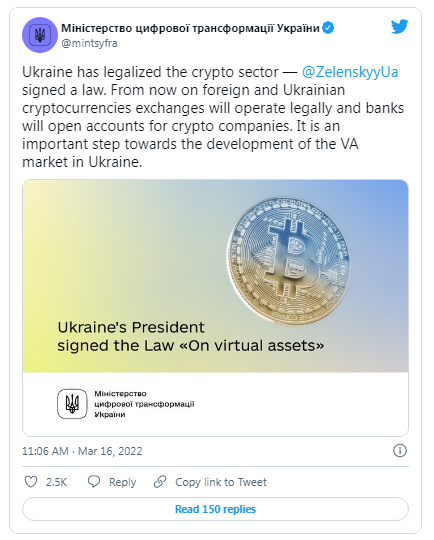


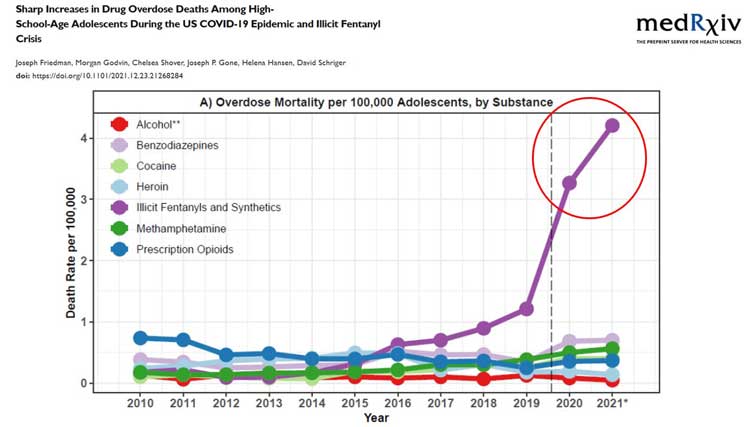


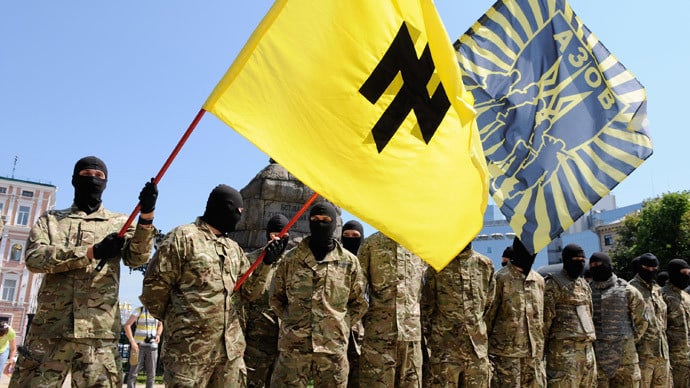




































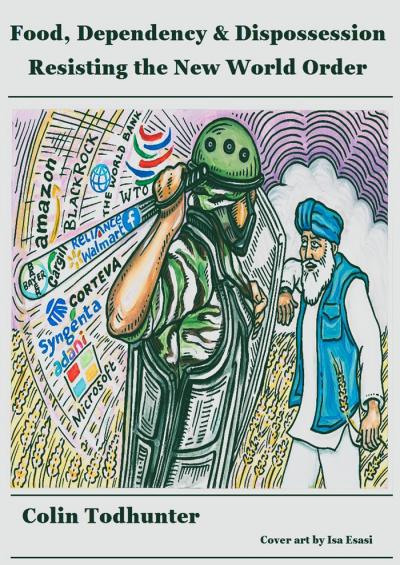 Read Colin Todhunter’s e-Book entitled
Read Colin Todhunter’s e-Book entitled






























